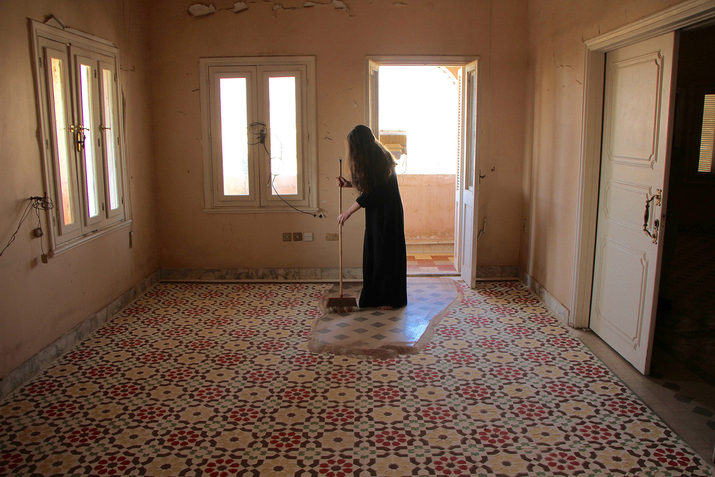-
From Current Issue
-
- Editor’s Letter Fire in the Heart
- Reviews I Gusti Ayu Kadek Murniasih
- Reviews 11th Seoul Mediacity Biennale: “One Escape at a Time”
- Dispatch Networked China
- One on One Monira Al Qadiri on Yukio Mishima
- Essays The rise of independent art spaces in pandemic-era Shanghai
- Features Tuan Andrew Nguyen
- Table of Contents
- Web Exclusives
- Archive
- Subscribe

R
E
V N
E
X
T
ZAHRAH AL-GHAMDI, Cell of the City, 2017, sand, clay and cloth, approximately 400 × 400 cm. Photo by Andy Stagg. Courtesy The Mosaic Rooms, London.
The first half of July saw London welcome a plethora of exhibitions and events as part of Shubbak, a biennial festival of contemporary Arab art and culture taking place in venues throughout the city. Among them, The Mosaic Rooms cultural space invited three young, female Saudi artists to contribute works for “Shift.” The exhibition, which included installations by Zahrah al-Ghamdi, Dana Awartani and Reem al-Nasser justified its name by exploring changes in both the physical and cultural landscapes of Saudi Arabia.
On the wall of the center’s ground floor gallery hung an iteration of al-Ghamdi’s Cell of the City (2017), made on-site. Constructed from sand, clay and cloth, the heavily textured relief hung in layered strips from the wall, and was intended to represent the traditional and increasingly abandoned architectural styles of southwest Saudi Arabia amid which the artist grew up. The work’s power lay in its transience, and its contrast with the space it occupied. Whereas the white cube is sterile and timeless by design, al-Ghamdi’s choice of materials and their earthy, organic texture and color succumbed to change over time. Drawing further attention to this contrast, the since-dried clay slip marks the walls around and beneath the central sculpture and, on the floor below, a layer of dust blankets the floor. As it thins away from the wall and bears the marks of visitors’ footprints, the encroachment of one kind of space on another is made manifest.
Also on the ground floor and exploring the encroachment of opposing aesthetics was Awartani’s I went away and forgot you. A while ago I remembered. I remembered I’d forgotten you. I was dreaming (2017). In the late 1950s and early 1960s, the people of Jeddah began to abandon their traditional Hijazi architectural style in favour of homes built in the French and Italian fashions, which had been made popular by the flourishing of Belle Époque architecture in Egypt during the 19th-century Khedivial period. A video installation displays the interior of one of these European-style houses in Jeddah, except with distinctly non-European flooring. What appears to be exquisitely detailed and colored tiling in the traditional Arab-Islamic style is revealed, when the artist enters wielding a broom, to be a meticulous arrangement of hand-dyed sand. As she sweeps away the fruit of what was surely significant labor, revealing dull cream and black tiles and leaving a pile of mixed, monochrome sand in the heart of the room, there is a sense of terrible satisfaction—the kind that can arise from destruction before one considers what is lost. It is perhaps less painful to see such an act after the fact, captured in a video, than it would be in real life and real time, and so in an adjacent room the artist recreated the original installation, with a plan to repeat its destruction toward the end of the exhibition. From something that appears so conceptually simple a plethora of meanings arise, and among them questions of complicity. With even the artist sweeping tradition away, how might the sands of time be turned?
Al-Nasser’s The Silver Plate (2017) occupied the center’s basement and, although its constituent parts each showed promise, the installation failed to form a coherent whole. Visitors’ experience of the piece begins as they approach the basement, and the nearly whispered Arabic words “qareeb” (near) and “ba’eed” (far) become audible from behind a heavy black curtain. In a dark room behind this veil, a two-channel video installation sporadically projects footage on two opposing walls. On the first screen, fingers tap rhythmically on a metal bowl—a traditional celebratory gesture at Saudi weddings—while on the second water drips into another. Outside the space visitors are invited to take a booklet on each of whose pages is a series of concentric circles, described as “free space for your feelings.” While, at times, The Silver Plate successfully bridges a gap between sensations of promise and foreboding, ostensibly in a bid to reflect the artist’s experience as a Saudi woman, its elements are mostly too disparate to express anything beyond its immediate surroundings. It was, then, an exception in an exhibition where the ability of objects to express cultural identity within and beyond its immediate space was so cogently explored.
“Shift” is on view at The Mosaic Rooms, London, until September 2, 2017.
To read more of ArtAsiaPacific’s articles, visit our Digital Library.







